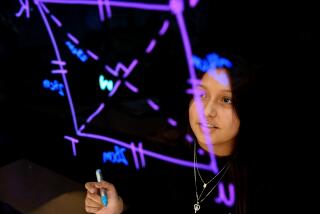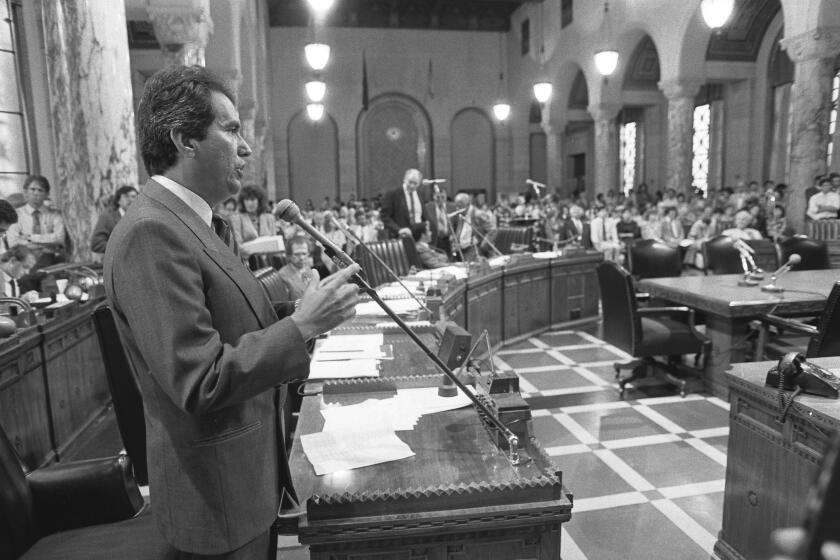Marian Wagstaff dies at 97; teacher integrated Compton school’s faculty in 1940s
Marian Wagstaff, a far-sighted educator who turned a Compton school into a model of racial harmony and integrated its faculty years before the court rulings and civil rights protests of the 1950s and ‘60s, died April 26 at a nursing home in Santa Cruz. She was 97.
Her death was due to old age, said a friend, Wini Jackson.
Wagstaff, who was white, became principal of Willowbrook Junior High School in 1945, as World War II ended and the demographics of Compton began to change. She integrated the faculty, hiring the school’s first black teacher in 1949, and created a camp in the San Bernardino Mountains to promote interracial cooperation that eventually drew students from schools across Los Angeles County.
FOR THE RECORD:
Wagstaff obituary: The obituary of educator Marian Wagstaff in Sunday’s California section said Adrian Dove helped organize a tribute dinner at the Dorothy Chandler Pavilion in 1999. He organized two prior events that honored Wagstaff but was not involved in planning the 1999 dinner. —
She left Willowbrook in 1952 to teach at Cal State L.A., where she trained new teachers for two decades and perpetuated the philosophy of all races and ethnicities working together that she called “the Willowbrook Way.”
“At Willowbrook she created a cocoon that was a beacon to the future,” said Adrian Dove, past president of the Los Angeles County Commission on Human Relations, who graduated from Willowbrook in 1950. “We didn’t know that everybody didn’t just get along.”
Dove helped organize a tribute dinner at the Dorothy Chandler Pavilion in 1999 that was attended by several hundred graduates of Centennial High School, where Willowbrook students matriculated.
Although Wagstaff never worked at Centennial, she influenced generations of its students, including Dove, through the Willowbrook teachers who later joined the Centennial faculty.
One of those teachers was John Redfud, who had taught in Louisiana before moving to Los Angeles to earn his master’s degree at USC in the 1940s.
Despite his qualifications, he could not find a teaching job in Los Angeles until Wagstaff hired him at Willowbrook in the early 1950s. A charismatic teacher who was known for his high expectations and inspirational tactics, Redfud went on to help open Centennial High.
Another of Wagstaff’s hires, Aaron Wade, went from Willowbrook and Centennial to become superintendent of the Compton school district.
“I didn’t hire black teachers. I hired the best teachers,” Wagstaff said in The Times in 1999. “I would only hire those teachers who loved children and who were great teachers. That was all that mattered to me.”
Wagstaff was born April 23, 1912, in San Francisco. Her father, Harry Alexander Cavassa, was an Italian immigrant who ran a successful pharmacy and was known for his progressive views.
After graduating from San Francisco State, she taught in a one-room schoolhouse in South San Francisco for 10 years, until she moved to Southern California in 1943 to become Willowbrook’s assistant principal. By then she had earned a master’s degree at Stanford University. She earned a doctorate at Stanford in 1958.
She married Wendell Wagstaff, a civil engineer, in 1940. He died in 1998. They had no children.
During her seven-year tenure as Willowbrook principal, Wagstaff hired four black teachers. Dove recalled that some white teachers and students left the school in protest, but that most stayed.
Wagstaff created an array of clubs and other activities to strengthen relations within the diversifying student body.
She had Japanese American students recently released from World War II relocation camps going to dances with the sons and daughters of Dust Bowl refugees, Mexican migrants and black war veterans.
Her embrace of multiculturalism preceded Brown vs. Board of Education, the landmark 1954 Supreme Court decision outlawing school segregation, and the civil rights protests of Rosa Parks and the Rev. Martin Luther King Jr.
“She was blatantly going against the grain,” Dove said, recalling that Wagstaff began integrating Willowbrook’s faculty soon after an incident at Fremont High School in South-Central Los Angeles, where two black students were hung in effigy in 1948.
In 1951 and again in 1952, Willowbrook was one of 40 schools nationwide to be honored by the Freedoms Foundation in Valley Forge, Pa., for teaching what the foundation called the American way of life.
To Wagstaff, that meant looking beyond skin color to bring Americans together.
On the way to Valley Forge in 1952, she stopped for lunch at a restaurant in Washington, D.C., with two of her student body presidents -- Joyce Ewing, who was black, and Eddie Martinez, a Latino -- and their local hostess, a distinguished African American woman. They were refused service by the white-run establishment.
The African American woman looked pained, Martinez recalled. But Wagstaff “just smiled, reached over and grabbed her friend and said, ‘Come, dear, we’ll find another restaurant.’ She was way above it,” said Martinez, an artist who has created works for Disney theme parks.
“She represented a better way . . . to not look at people superficially but as human beings,” Martinez said in an interview Friday. “That’s what I learned from her.”
A memorial service will be held at 11 a.m. June 27 at a site to be determined on the Cal State L.A. campus. For more information, contact Warner Davis at (760) 721-5297 or Vic Pierce at vicpierce@earthlink.net.
More to Read
Start your day right
Sign up for Essential California for the L.A. Times biggest news, features and recommendations in your inbox six days a week.
You may occasionally receive promotional content from the Los Angeles Times.








